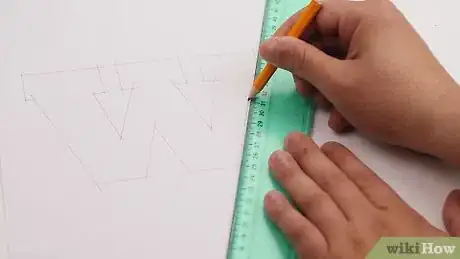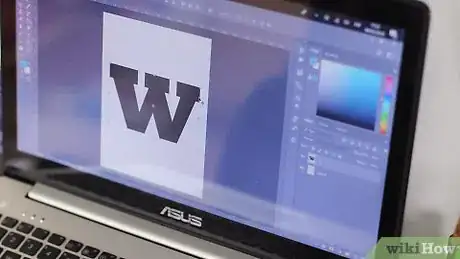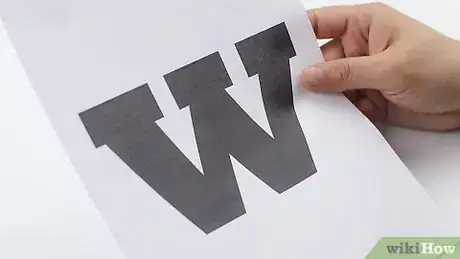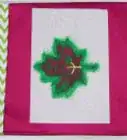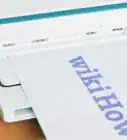This article was co-authored by Joy Cho. Joy Cho is the Founder and Creative Director of the lifestyle brand and design studio, Oh Joy!, founded in 2005 and based in Los Angeles, California. She has authored six books and consulted for creative businesses around the world. Joy has lectured on business, leadership, and entrepreneurship at conferences and companies such as AltSummit, Pinterest, Target, and Hallmark, while her home and studio have been featured in magazines such as House Beautiful, Parents, and Domino. She has also been named one of Time's 30 Most Influential People on the Internet multiple times and has the most followed account on Pinterest with more than 14 million followers.
There are 9 references cited in this article, which can be found at the bottom of the page.
This article has been viewed 224,320 times.
Stencil printing is a less expensive, cleaner, and a simpler alternative to screen printing. It is an easy way for you to print an image, or several images, repeatedly on a surface, like a poster or a t-shirt.[1] Even better, unlike screen printing, stencil printing doesn't require you to use any smelly chemicals! All you need are a few supplies, an image you want to transfer, and a little bit of effort. Before long you'll have a stencil you can use to print your image as much as you desire.
Steps
Making Your Stencil
-
1Brainstorm your stencil ideas. If you plan on creating an original design, you might want to take a piece of paper and a pencil to sketch out some concept designs. If you plan on using a pre-made image, like one used by your favorite artist, video game, or TV show, you should should find a high resolution copy of the image. High resolution images will result in crisper, cleaner stencils.[2]
- Beginners might want to stick with simple designs while learning the basics of stencil printing. A simple line drawing or thick, plain, black text will work well for your stencil.[3]
-
2Create your design. This can be easily done on a computer with image editing software, like Adobe Photoshop or MS Paint. You might import an image from online or your personal image library and make some modifications to it with your editing software, or you might use your own original artwork. If you don't have a printer, you can always look into how to make a stencil by hand.
- With image editing software, it will be easy for you to move around components of the design until you are happy with it. Text, in particular, will likely require some adjustment for you to get the right placement and size.[4]
- Compare the size of your design to your substrate, which is the technical name for the thing you'll be stenciling onto later. This will prevent you from creating a stencil that is too large.
- Some examples of substrates you might stencil your design onto include: t-shirts, backpacks, posters, towels, walls, folders, and so on.
- You might want to change your image properties to "Black and white" before printing. This will make it easier to identify the parts you will need to cut from your image to make your stencil.[5]
Advertisement -
3Print your design. You should print your image in black and white on a sturdy piece of paper, like card stock or posterboard. Depending on your printer, you may be able to cut a piece of white posterboard or card stock down to the size of a normal sheet of paper and use it in your printer as you would normally.
- Depending on your region and printer, your standard paper size may vary. Generally, you can expect most printers to accept paper 8.5 inches (21.6 cm) wide.
- Sturdy paper will result in a sturdier stencil. Using normal paper for your stencil might cause it to fall apart while stenciling.[6]
-
4Cut your stencil free of the paper. Take your utility knife and cut around the perimeter of the black areas of your image. Try to cut in an unbroken line around the perimeter to limit the number of touch-ups you'll need to make at the end. If you need to cut through the blank space surrounding your image, cut a thin line from the border of the page to the perimeter of your image, then cut the image free by following its perimeter.
- Do not throw away any of the pieces of your stencil. Depending on the kind of stencil you want to make, you might use either the white pieces or the black pieces when stenciling.
- Be careful not to trim floating or protruding ares of white space. Even if a white space is mostly or completely surrounded by the black of your image, you should keep it. All white pieces should stay together with other white pieces and black pieces with black pieces.
- In stencil making, the white part of your stencil is called the positive stencil while the black parts make up the negative stencil.[7]
- Be careful not to damage the surface you are cutting on! You may want to put a piece of cardboard or a self-healing cutting mat beneath your design while cutting.[8]
Using Your Stencil
-
1Position your substrate. The best place to apply your stencil is a clean, sturdy, flat surface, like a table, desk, or counter. Make sure your substrate and surface are both clean before placing it onto your surface.[9]
- Put an extra layer of unused posterboard or card stock beneath your substrate so it is under the area you plan on applying your stencil. In the event your paint bleeds through, this will prevent an unnecessary mess on your surface.
- If you plan on stenciling bags and backpacks, you should insert a piece of stiff cardboard inside to prevent your paint bleeding through to the inside or opposite side of the bag.
- If you don't have cardboard or extra posterboard/card stock, you can always use an old board game box.
-
2Decide between positive and negative stencils. Before you go any further, you'll have to figure out which stencil you'll be using: the positive (white) or negative (black). Positive stencils are great for letters and outlines. They also give the appearance of your image being part of the background of your shirt. Negative stencils are better for figures and details. Negative stenciled images will appear to be in the foreground of your shirt.[10]
-
3Mark your stencil placement with painter's tape. This is especially important for your negative stencil, as you will not have the border of your page to orient your stencil as you will with your positive stencil. Using small pieces of painter's tape, mark the placement of your stencils.
- With painter's tape marking positioning, you'll have an easier time aligning your stencils with your substrate. Your tape guides will also prevent you from stenciling something crooked.
- The positive stencil will be the easier of the two to position on your substrate. Use the outer edges of the page of your positive stencil to place it and mark its position with tape.
- To mark the position of your negative stencil, first place your positive one. Use the outer borders of the page of your positive stencil to position it precisely. Then mark the interior of the positive stencil. This is where you will need to place your negative stencil before applying your paint.
-
4Place your stencil. Hold your substrate free of its surface and allow it to hang naturally in your hands. While holding the substrate, check to see that your painter's tape guides are even and straight; small errors will result in a skewed or uneven image. Return your substrate to its surface and correct any errors in tape placement, then align your stencil with your tape guides.
- Stencils can sometimes stick to your paint applicator and come free from the substrate. This can sometimes result in poor image quality. To prevent this, you can use double sided tape (or a loop of tape with the sticky side out) to attach your stencil to the substrate.[11]
-
5Paint your stencil. If you're using the positive stencil, you'll be painting its inside. If you're using the negative stencil, you'll be painting the outside. In either case, it doesn't matter if you get paint on your stencil. You should not, however, get paint under the stencil; this will result in the border of your design being irregular and not looking clean.
- Use fabric paint if you're stenciling on fabric, like a T-shirt.[12]
- If you're using fabric paint, you may need to dilute it first so it's not too thick. Check the instructions on the paint.[13]
- Pour a moderate amount of your suitable paint into a paint tray. In place of a paint tray you could use several paper plates or even pieces of wax paper. Then, using either a brush or sponge, transfer paint to your substrate.
- If you don't have a paint brush or sponge, you can always use cheap hand towels or rags. Layer a few of these together and roll them up to make a fabric tube. This will be your makeshift applicator; dip it into your paint and dab it onto your substrate.
- Be careful not to rub or brush against your paint while it is wet. This can cause it to smear and can even result in a stain on the clothing you are wearing.[14] [15]
Drying and Finishing Your Stenciling
-
1Wait for your paint to dry completely. Removing your stencils before the paint is completely dry can result in paint-smear. Be patient while waiting for your stenciled image to dry. To speed this process, you might use a hair dryer or low intensity fan directed at the drying paint.
- Another technique that you might use to help your design dry involves an iron and wax paper. Lay your wax paper over your design and, in short intervals, run the iron over the wax paper slowly but steadily.[16]
-
2Remove your stencil or add another coat. When your paint is fully dry, peel one edge of your stencil carefully away from your substrate. Do not remove your stencil completely at this point. With your stencil still mostly attached to your substrate, check the first layer of paint you used for your stencil design. If it looks thin or light in color, reattach the corner of the stencil you've peeled away and apply another coat of paint.
- If your first layer of paint is consistent and you have achieved the desired color, continue to peel your stencil free from the substrate until it is completely removed. If you plan on using your stencil again, place it somewhere safe; otherwise you can throw it away.[17]
-
3Add finishing touches with a paintbrush. Now that your paint is dry, you can add artistic touches to your design. Especially if the negative space where you applied your paint is lacking in color or personality, use your paints and a brush to add personal touches to the design.
- Some stencils might not transfer certain features very well, like eyes, for example. In this case, you might want to use a paintbrush to add these features.[18]
-
4Dry your finishing touches and enjoy. You can do this in the same fashion you did previously. Either wait until the paint is dry or speed the process along with a blow dryer. When the paint of your finishing touches is dry, your stencil printing project is complete.
Expert Q&A
Did you know you can get expert answers for this article?
Unlock expert answers by supporting wikiHow
-
QuestionHow can I make sure my stencil print comes out neat and clean?
 Joy ChoJoy Cho is the Founder and Creative Director of the lifestyle brand and design studio, Oh Joy!, founded in 2005 and based in Los Angeles, California. She has authored six books and consulted for creative businesses around the world. Joy has lectured on business, leadership, and entrepreneurship at conferences and companies such as AltSummit, Pinterest, Target, and Hallmark, while her home and studio have been featured in magazines such as House Beautiful, Parents, and Domino. She has also been named one of Time's 30 Most Influential People on the Internet multiple times and has the most followed account on Pinterest with more than 14 million followers.
Joy ChoJoy Cho is the Founder and Creative Director of the lifestyle brand and design studio, Oh Joy!, founded in 2005 and based in Los Angeles, California. She has authored six books and consulted for creative businesses around the world. Joy has lectured on business, leadership, and entrepreneurship at conferences and companies such as AltSummit, Pinterest, Target, and Hallmark, while her home and studio have been featured in magazines such as House Beautiful, Parents, and Domino. She has also been named one of Time's 30 Most Influential People on the Internet multiple times and has the most followed account on Pinterest with more than 14 million followers.
Designer & Style Expert, Oh Joy!
-
QuestionAny tips for making a very small stencil?
 Community AnswerUse a thicker stencil paper (such as thin cardboard/cardstock) to create crisper lines, since the stencil design will be small and therefore more detailed. It might be better to use a small paintbrush (as opposed to spray paint) to have more control over where the paint goes.
Community AnswerUse a thicker stencil paper (such as thin cardboard/cardstock) to create crisper lines, since the stencil design will be small and therefore more detailed. It might be better to use a small paintbrush (as opposed to spray paint) to have more control over where the paint goes. -
QuestionCan I just use a sponge to paint it?
 Community AnswerYes. Sponge it lightly or several times, depending on the color you want.
Community AnswerYes. Sponge it lightly or several times, depending on the color you want.
Warnings
- You may have less than satisfactory results if you try to print on nylon or plastic. These materials can be difficult to work with when stencil printing.⧼thumbs_response⧽
- Utility blades are sharp; keep these out of reach of children. You should supervise the usage of all tools that are potentially dangerous.⧼thumbs_response⧽
- Hot irons are dangerous; keep these out of reach of children.⧼thumbs_response⧽
Things You'll Need
- Cheap hand towels (optional)
- Computer with image editing program
- Paint
- Paintbrushes
- Painter's tape
- Paper plates
- Posterboard (or card stock)
- Printer (or sharpie marker and drawing ability)
- Scissors
- Substrate (the object you'll be printing on)
- Utility knife (like an x-acto knife)
- Wax paper (optional)
References
- ↑ http://www.britannica.com/art/stenciling
- ↑ http://www.digital-photo-secrets.com/tip/1711/what-is-image-resolution-why-does-it-matter/
- ↑ http://www.rookiemag.com/2013/05/diy-stenciling/
- ↑ http://realitydaydream.com/2012/04/tutorial-how-to-make-your-own-stencil.html
- ↑ http://www.rookiemag.com/2013/05/diy-stenciling/
- ↑ http://realitydaydream.com/2012/04/tutorial-how-to-make-your-own-stencil.html
- ↑ http://journal.alabamachanin.com/2016/01/on-designing-stencils/
- ↑ http://www.melissaevans.com/tutorials/stencil-art-printing-t-shirts
- ↑ http://www.curbly.com/users/chrisjob/posts/1355-print-your-own-t-shirts-using-homemade-stencils
- ↑ http://journal.alabamachanin.com/2016/01/on-designing-stencils/
- ↑ http://realitydaydream.com/2012/04/tutorial-how-to-make-your-own-stencil.html
- ↑ Joy Cho. Crafting Professional. Expert Interview. 3 July 2019.
- ↑ Joy Cho. Crafting Professional. Expert Interview. 3 July 2019.
- ↑ http://www.rookiemag.com/2013/05/diy-stenciling/
- ↑ http://www.curbly.com/users/chrisjob/posts/1355-print-your-own-t-shirts-using-homemade-stencils
- ↑ http://www.pburch.net/dyeing/fabricpaints.shtml
- ↑ http://www.rookiemag.com/2013/05/diy-stenciling/
- ↑ http://www.rookiemag.com/2013/05/diy-stenciling/
About This Article
If you want to stencil print, put the item you want to print on, like a t-shirt, on a flat surface. Then, attach your stencil to the item with double-sided painter's tape so it stays in place. For a positive stencil, paint the shape inside the stencil with a brush or sponge. Next, wait for the paint to dry before applying another coat. Alternatively, you can remove the stencil if you've got the color you want from the first coat. Finally, apply finishing touches if required, like eyes or a nose. For tips on how to design a stencil and how to apply a negative stencil, read on!
